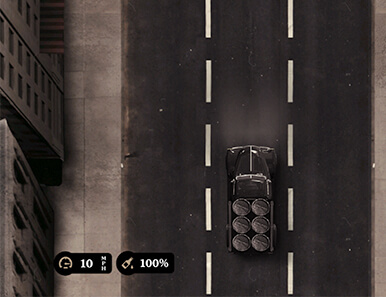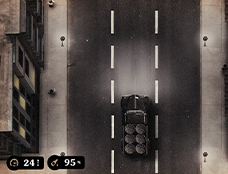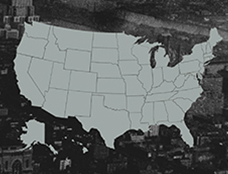Scroll for an interactive journey
through the history of Prohibition
Chapter 1: The Road to Prohibition

Get the booze to the stash house!
Play the Game The Road to Prohibition
Read More The Building Blocks of Prohibition Decades of temperance activism, as well as anti-immigrant sentiment in the wake of World War I, culminated in passage of the 18th Amendment in 1919.
The Road to Prohibition
Read More Women Led the Temperance Charge Widespread drunkenness, especially among American men, during the 19th century gave rise to the temperance movement, which aimed to improve the health and well-being of Americans through alcohol abstinence.
The Prohibition Underworld
Read More The Speakeasies of the 1920s When Prohibition took effect in 1920, some Americans had no intention of abandoning their enjoyment of alcohol. They found what they were looking for in underground drinking establishments, commonly called speakeasies, which became crucibles for dramatic social and cultural change.
The Prohibition Underworld
Read More Queens of the Speakeasies Texas Guinan, Helen Morgan and Belle Livingstone lit up speakeasy culture and exemplified the liberated woman during Prohibition.
The Prohibition Underworld
Read More Bootleggers and Bathtub Gin During Prohibition, illegal booze was made in every conceivable way, from small-scale “alky cooking” in the home to large-scale manufacturing operations controlled by Mob racketeers.
The Prohibition Underworld
Read More Alcohol as Medicine and Poison Prohibition laws included two exceptions that allowed legal consumption of alcohol for medicinal and religious reasons, and organized crime took full advantage of the loopholes. The production of industrial-grade alcohol, meanwhile, turned fatal, as thousands died from swallowing the poisonous substance.
The Rise of Organized Crime
Read More Prohibition Profits Transformed the Mob Prohibition was the best thing that ever happened to organized crime. Thanks to the proceeds of providing illegal liquor, small-time street gangs grew into regional crime syndicates.
The Rise of Organized Crime
Read More Rumrunners Delivered the Good Stuff to America’s Speakeasies From Canada to the Caribbean, rum runners smuggled liquor into the United States, supplying high-quality whiskey and rum to thirsty speakeasy patrons.
Enforcing the Prohibition Laws
Read More Prohibition Agents Lacked Training, Numbers to Battle Bootleggers Small budgets and meager training made it difficult for Prohibition agents to combat the rise of organized crime during Prohibition.
Enforcing the Prohibition Laws
Read More Key Court Rulings Enhanced Prohibition Enforcement In two landmark cases, the U.S. Supreme Court gave law enforcement more tools to go after Prohibition violators.
Enforcing the Prohibition Laws
Read More During Prohibition, Mob Bosses Tripped Up By Tax Laws Although liquor enforcement was ineffective in many cities during Prohibition, the federal government eventually found a more successful way to attack organized crime: targeting tax evaders.
How Prohibition Changed American Culture
Read More Women’s Rights Advanced During Prohibition During Prohibition, women gained the right to vote, but they also enjoyed greater autonomy in their private lives: at home, in the workplace and in relationships.
How Prohibition Changed American Culture
Read More The Rise of Jazz and Jukeboxes The thousands of speakeasies that opened during Prohibition created venues for jazz musicians to make a living and grow the audience for their emerging musical style. The invention of the jukebox spread popular music far and wide.
How Prohibition Changed American Culture
Read More Flappers and Gangsters Ruled the Silver Screen The cultural revolutions of the Prohibition era were reflected in the movies produced by Hollywood, which made the flapper and the gangster into movie house mainstays.
How Prohibition Changed American Culture
Read More Prohibition Sparked a Women’s Fashion Revolution Women during the 1920s abandoned the styles of their Victorian-era mothers and embraced bobs, beads and higher hemlines. The “flapper” eschewed corsets and floor-length gowns in favor of free-flowing, ornately decorated attire.
How Prohibition Changed American Culture
Read More Dating Replaced Courtship During Prohibition The 1920s saw the demise of traditional courting rituals as newly empowered and liberated women danced, drank and mingled with men in public places without chaperones on their heels.
How Prohibition Changed American Culture
Read More Mixed Drinks Made Rotgut Liquor Palatable Cocktails were invented before Prohibition, but they became particularly popular to soothe the burn of rudimentary liquors produced during Prohibition.
Prohibition Potpourri
Read More NASCAR Rooted in Prohibition Bootlegging Bootleggers needed fast cars and skilled drivers to evade law enforcement while getting their products to market. Some of the most skilled booze runners and mechanics went on to form the foundation of stock car racing.
Prohibition Potpourri
Read More Brewers and Distillers Found Creative Ways to Survive When Prohibition took effect, many brewers, distilleries and vineyards were put out of business. But some converted their operations to make other products, including cheese, ice cream and even pottery.
Prohibition Potpourri
Read More Odd Facts and Stories from Prohibition The Prohibition era produced many interesting characters and wild stories. But it can be a challenge to separate fact from myth.
Prohibition Potpourri
Read More Gold Diggers, Snuggle Pups and the Bee’s Knees Prohibition generated a slew of slang terms, some of which are still used today.
Prohibition Potpourri
Read More Notable Names of Prohibition From jazz legend Louis Armstrong to temperance advocate Wayne Wheeler, the Prohibition era had a cast of important and unforgettable characters.
Prohibition in Las Vegas
Read More In Las Vegas, Prohibition Was Sporadically Enforced Prohibition was the law of the land, but in Las Vegas alcohol flowed more freely than in many other places. Still, Prohibition agents occasionally cracked down on the small city’s saloon proprietors.
The End of Prohibition
Read More The Repeal of Prohibition After years of hapless enforcement and with public support lagging, the 18th Amendment was repealed in 1933.Prohibition was deemed a failure, and soon after Franklin D. Roosevelt was elected president in 1932, the 18th Amendment was repealed.
The End of Prohibition
Read More The Remnants of Prohibition National Prohibition ended on December 5, 1933, but state and local restrictions on liquor sales are still in place across the country to this day.
What's Next?

Get the booze to the stash house!
Play the Game
Dig deeper into the stories
Read the Stories
What are your state’s laws?
View the Map

